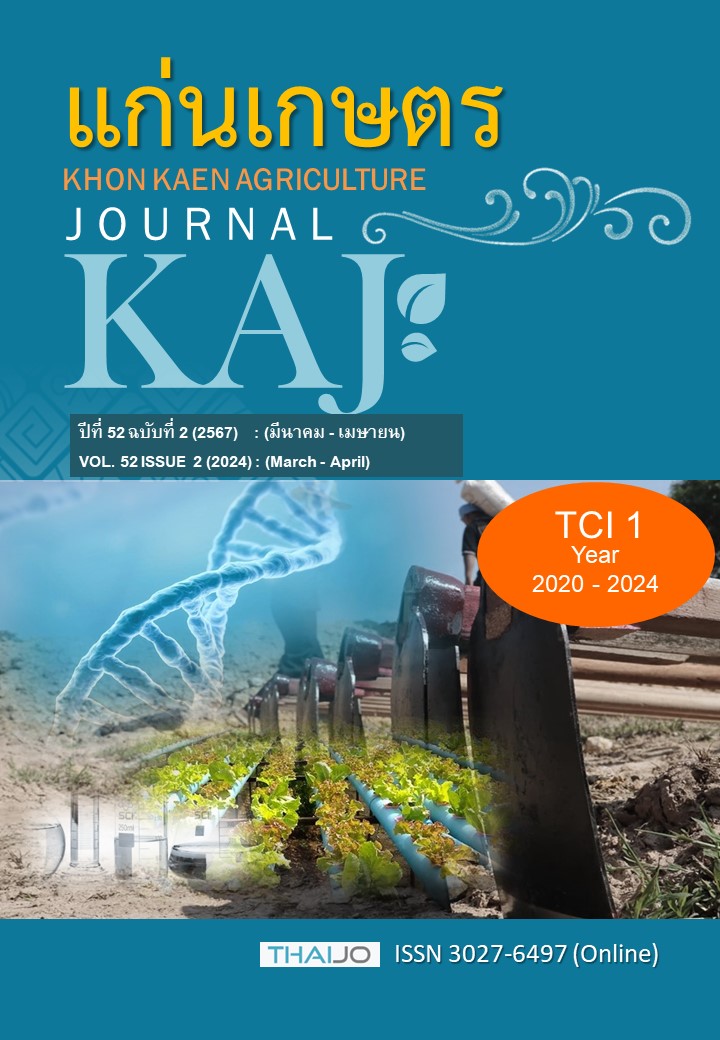การพัฒนาเครื่องหมายโมเลกุลที่สัมพันธ์กับอายุวันออกดอกสั้นในประชากร F2 ของพันธุ์ข้าว กข79 กับสายพันธุ์ กข43 ข้าวเหนียวหอม
Main Article Content
บทคัดย่อ
อายุวันออกดอกของข้าวเป็นลักษณะทางการเกษตรที่สำคัญสำหรับการปรับตัวให้เข้ากับสภาพแวดล้อม ซึ่งมีผลต่อปริมาณและคุณภาพของผลผลิตข้าว อายุวันออกดอกเป็นลักษณะเชิงปริมาณที่ถูกควบคุมด้วยยีนหลายคู่และสภาพแวดล้อมมีอิทธิพล โดยเฉพาะความยาวของช่วงแสง ในงานวิจัยนี้มีวัตถุประสงค์เพื่อพัฒนาเครื่องหมายโมเลกุลที่สัมพันธ์กับอายุวันออกดอกสั้นในประชากร F2 คู่ผสมระหว่างข้าวพันธุ์ กข79 (พันธุ์แม่) กับสายพันธุ์ กข43 ข้าวเหนียวหอม ที่มีอายุวันออกดอกสั้น (พันธุ์พ่อ) ศึกษาทั้งในสภาพวันยาวและสภาพวันสั้น โดยนำข้าวพันธุ์แม่และพันธุ์พ่อไปอ่านลำดับดีเอ็นเอทั้งจีโนม (whole genome sequencing; WGS) เพื่อมาวิเคราะห์หาตำแหน่งสนิปส์ (SNPs) และ อินเดล (InDel) ที่แตกต่างกันภายในเอ็กซอนของยีนที่ควบคุมอายุวันออกดอกสั้น และพัฒนาเครื่องหมายโมเลกุลที่เป็นส่วนหนึ่งของยีนและสามารถแยกความแตกต่างระหว่างข้าวพันธุ์แม่กับข้าวพันธุ์พ่อได้ชัดเจน แล้วนำเครื่องหมายโมเลกุลไปหาความสัมพันธ์กับอายุวันออกดอกสั้นของประชากร F2 ในสภาพวันยาวและสภาพวันสั้น ผลจากการวิเคราะห์สมการถดถอยเชิงเดียว จีโนไทป์ของเครื่องหมายโมเลกุลที่เป็นส่วนหนึ่งของยีน Hd5 มีความสัมพันธ์กับอายุวันออกดอกสั้นมากที่สุด โดยมีค่าสัมประสิทธิ์การตัดสินใจ (R2) เท่ากับ 50.94% ในสภาพวันยาว และ 54.81% ในสภาพวันสั้น และจากการวิเคราะห์ถดถอยพหุคูณระหว่างเครื่องหมายโมเลกุลกับอายุวันออกดอกสั้น พบว่า การใช้เครื่องหมายโมเลกุลที่เป็นส่วนหนึ่งของยีน Hd5 ร่วมกับ RFT1 มีความสัมพันธ์กับอายุวันออกดอกสั้นมากที่สุด โดยมีค่า R2 เท่ากับ 76.51% ในสภาพวันยาว และ 68.25% ในสภาพวันสั้นซึ่งสามารถใช้ปรับปรุงพันธุ์ข้าวในประชากรนี้ให้มีอายุวันออกดอกสั้นต่อไปได้อย่างมีประสิทธิภาพ
Article Details

อนุญาตภายใต้เงื่อนไข Creative Commons Attribution-NonCommercial-NoDerivatives 4.0 International License.
เอกสารอ้างอิง
กองวิจัยและพัฒนาข้าว กรมการข้าว. 2563. องค์ความรู้เรื่องข้าว. แหล่งข้อมูล http://www.ricethailand.go.th/ rkb3/Disease.htm. ค้นเมื่อ 31 ตุลาคม 2563.
การเงินธนาคาร. 2563. ส่งออกข้าวไทยปี 63 ทรุดต่อเนื่อง มุ่งพัฒนาข้าวขาวพื้นนิ่ม เพื่อเป็น Fighting Product. แหล่งข้อมูล https://www.moneyandbanking.co.th/article/news/kreserch-thairice-01042020/. ค้นเมื่อ 30 สิงหาคม 2564.
ชัยวัฒน์ สร้อยเจริญสุข. 2566. แนวโน้มธุรกิจ/อุตสาหกรรม 2566-2568: อุตสาหกรรมข้าว. แหล่งข้อมูล: https://www.krungsri.com/th/research/industry/industry-outlook/agriculture/rice/io/io-rice-2023-2025. ค้นเมื่อ 9 ธันวาคม 2566.
ฐานเศรษฐกิจ. 2562. ส่องอนาคต “กข79” รุ่งหรือร่วง. แหล่งข้อมูล https://www.thansettakij.com/content /Macro_econ/412010. ค้นเมื่อ 30 สิงหาคม 2564.
ฐานเศรษฐกิจ. 2563. เดินตามแผน “บิ๊กตู่” ปั้นข้าวกข79 ป้อนตลาดโลก. แหล่งข้อมูล https://www.thansettakij. com/business/438286. ค้นเมื่อ 30 สิงหาคม 2564.
ประชาชาติธุรกิจ. 2564. เศรษฐกิจในประเทศ เฟ้นหา “พันธุ์ข้าวใหม่” กู้ส่งออก 4 เดือนไทยตกอันดับ. แหล่งข้อมูล: https://www.prachachat.net/economy/news-678734. ค้นเมื่อ 1 กรกฎาคม 2564.
สมถวิล วิจิตรวรรณา. 2565. สถิติความสัมพันธ์: เลือกใช้อย่างไร. วารสารมนุษยศาสตร์และ สังคมศาสตร์ มหาวิทยาลัยราชพฤกษ. 8(2): 1-15.
สำนักงานพัฒนาวิทยาศาสตร์และเทคโนโลยีแห่งชาติ. 2564. "จีโนมข้าว" ตัวเร่งการพัฒนาพันธุ์ข้าวไทย. แหล่งข้อมูล https://www.nstda.or.th/home/performance_post/rice-genome/. ค้นเมื่อ 26 กันยายน 2564.
Doi, K., T. Izawa, T. Fuse, U. Yamanouchi, T. Kubo, Z. Shimatani, M. Yano, and A. Yoshimura. 2004. Ehd1, a B-type response regulator in rice, confers short-day promotion of flowering and controls FT-Iike gene expression independently of Hd1. Journal of Genes and Development. 18: 926-936.
Fujino, K., U. Yamanouchi, and M. Yano. 2013. Roles of the Hd5 gene controlling heading date for adaptation to the north ern limits of rice cultivation. Journal of Theoretical and Applied Genetics. 126: 611-618.
Hayama, R., S. Yokoi, S. Tamaki, M. Yano, and K. Shimamoto. 2003. Adaptation of photoperiodic control pathways produces short-day flowering in rice. Journal of Nature. 422: 719-722.
Kim, S. L., S. Lee, H. J. Kim, H. G. Nam, and G. An. 2007. OsMADS51 is a short-day flowering promoter that functions upstream of Ehd1, OsMADS14, and Hd3a. Journal of Plant Physiology. 145: 1484-1494.
Kojima, S., Y. Takahashi, Y. Kobayashi, L. Monna, T. Sasaki, T. Araki, and M. Yano. 2002. Hd3a, a rice ortholog of the Arabidopsis FT gene, promotes transition to flowering downstream of Hd1 under short-day conditions. Journal of Plant Cell Physiology. 43: 1096-1105.
Komiya, R., A. Ikegami, S. Tamaki, S. Yokoi, and K. Shimamoto. 2008. Hd3a and RFT1 are essential for flowering in rice. Journal of Development. 135: 767-774.
Komiya, R., S. Yokoi and K. Shimamoto. 2009. A gene network for long-day flowering activates RFT1 encoding a mobile flowering signal in rice. Journal of Development. 136: 3443-3450.
Laloum, T., S.D. Mita, P. Gamas, M. Baudin, and A. Niebel. 2013. CCAAT-box binding transcription factors in plants: Y so many ?. Journal of Trends in Plant Science. 18: 157-166.
Lee, Y. S., and G. An. 2015. Complex regulatory networks of flowering time in rice. Journal of Rice Research: Open Access. 3: 141.
Lin, H. X., T. Yamamoto, T. Sasaki, and M. Yano. 2000. Characterization and detection of epistatic interactions of three QTLs, Hd1, Hd2 and Hd3, controlling heading date in rice using nearly isogenic lines. Journal of Theoretical and Applied Genetics. 101: 1021-1028.
Nonoue, Y., K. Fujino, Y. Hirayama, U. Yamanouchi, S. Lin, and M. Yano. 2008. Detection of quantitative trait loci con trolling extremely early heading in rice. Journal of Theoretical and Applied Genetics. 116: 715-722.
Ogiso-Tanaka, E., K. Matsubara, S. Yamamoto, Y. Nonoue, J. Wu, H. Fujisawa, H. Ishikubo, T. Tanaka, T. Ando, T. Matsumoto, and M. Yano. 2013. Natural variation of the RICE FLOWERING LOCUS T 1 contributes to flowering time divergence in rice. Journal of PLoS One. 8(10): e75959.
Ryu, C. H., S. Lee, S. L. Kim, Y. S. Lee, S. C. Choi, H. J. Jeong, J. Yi, S. J. Park, C. D. Han, and G. An. 2009. OsMADS50 and OsMADS56 function antagonistically in regulating long day (LD)-dependent flowering in rice. Journal of Plant, Cell and Environment. 32: 1412-1427.
Takahashi, Y., K. M. Teshima, S. Yokoi, H. Innan, and K. Shimamoto. 2009. Variations in Hd1 proteins, Hd3a promoters, and Ehd1 expression levels contribute to diversity of flowering time in cultivated rice. Journal of Proceedings of the National Academy of Sciences. 106: 4555–4560.
Tsuji, H., S. Tamaki, R. Komiya, and K. Shimamoto. 2008. Florigen and the photoperiodic control of flowering in rice. Journal of Rice. 1: 25-35.
Vergara, B. S., and T.-T. Chang. 1985. The flowering response of the rice plant to photoperiod: a review of the literature. 4th Edition. IRRI, Los Baños.
Wei, X., J. Xu, H. Guo, L. Jiang, S. Chen, C. Yu, Z. Zhou, P. Hu, H. Zhai, and J. Wan. 2010. DTH8 suppresses flowering in rice, influencing plant height and yield potential simultaneously. Journal of Plant Physiology. 153: 1747-1758.
Xue, W., Y. Xing, X. Weng, Y. Zhao, W. Tang, L. Wang, H. Zhou, S. Yu, C. Xu, X. Li, and Q. Zhang. 2008. Natural variation in Ghd7 is an important regulator of heading date and yield potential in rice. Journal of Nature Genetics. 40: 761-767.
Yano, M., Y. Katayose, M. Ashikari, U. Yamanouchi, L. Monna, T. Fuse, T. Baba, K. Yamamoto, Y. Umehara, Y. Nagamura, and T. Sasaki. 2000. Hd1, a major photoperiod sensitivity quantitative trait locus in rice, is closely related to the arabidopsis flowering time gene CONSTANS. Journal of The Plant Cell. 12: 2473-2483.


